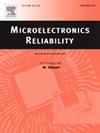A failure mechanism of 1.2 kV/20 A 4H-SiC Schottky barrier diodes under humidity and high reverse bias voltage
IF 1.6
4区 工程技术
Q3 ENGINEERING, ELECTRICAL & ELECTRONIC
引用次数: 0
Abstract
SiC power devices have higher blocking voltage, lower on-resistance, and higher operating temperature than Si-based devices, which can be widely used in electric vehicles, rail transit, and high-voltage power transmission. However, the more severe application environments put higher demands on their reliability. In this paper, 1.2 kV/20 A SiC Schottky Barrier Diodes (SBDs) were evaluated after subjected to a series of reliability tests, including high-temperature storage (HTS), low-temperature storage (LTS), high-temperature reverse bias (HTRB) and high voltage, high humidity, high temperature reverse biased (HV-H3TRB) test. All devices passed the HTS, LTS and HTRB tests, but only 80 % of the devices passed the HV-H3TRB, which was mainly caused by pre-breakdown before 1200 V. Failure analysis showed that the breakdown point was located at the edge of the termination with cracks and delamination of the passivation layer were observed. Of 80 % of the failed devices after HV- H3TRB, almost all showed failure mode of passivation layer damage. With the root cause, the failure mechanism has been identified. This indicates that the passivation layer plays a critical role to determine the reliability of a SiC SBD device.
求助全文
约1分钟内获得全文
求助全文
来源期刊

Microelectronics Reliability
工程技术-工程:电子与电气
CiteScore
3.30
自引率
12.50%
发文量
342
审稿时长
68 days
期刊介绍:
Microelectronics Reliability, is dedicated to disseminating the latest research results and related information on the reliability of microelectronic devices, circuits and systems, from materials, process and manufacturing, to design, testing and operation. The coverage of the journal includes the following topics: measurement, understanding and analysis; evaluation and prediction; modelling and simulation; methodologies and mitigation. Papers which combine reliability with other important areas of microelectronics engineering, such as design, fabrication, integration, testing, and field operation will also be welcome, and practical papers reporting case studies in the field and specific application domains are particularly encouraged.
Most accepted papers will be published as Research Papers, describing significant advances and completed work. Papers reviewing important developing topics of general interest may be accepted for publication as Review Papers. Urgent communications of a more preliminary nature and short reports on completed practical work of current interest may be considered for publication as Research Notes. All contributions are subject to peer review by leading experts in the field.
 求助内容:
求助内容: 应助结果提醒方式:
应助结果提醒方式:


